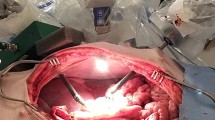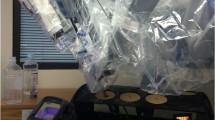Abstract
Background
Single-incision laparoscopic surgery (SILS) places multiple instruments in close, parallel proximity, an orientation that may have implications in the production of stray current from the monopolar “Bovie” instrument. The purpose of this study was to compare the energy transferred during SILS compared to traditional four-port laparoscopic surgery (TRD).
Method
In a laparoscopic simulator, instruments were inserted via SILS or TRD setup. The monopolar generator delivered energy to a laparoscopic L-hook instrument for 5-s activations on 30-Watts coag mode. The primary outcome (stray current) was quantified by measuring the heat of liver tissue held adjacent to the non-electrically active 10-mm telescope tip and Maryland grasper in both the SILS and TRD setups. To control for the potential confounder of stray energy coupling via wires outside the surgical field, the camera cord and active electrode wires were oriented parallel or completely separated.
Results
SILS and TRD setups create similar amounts of stray current as measured by increased tissue temperature at the non-electrically active telescope tip (41 ± 12 vs. 39 ± 10 °C; p = 0.71). Stray current was greater in SILS compared to TRD at the tip of the non-electrically active Maryland forceps (38 ± 9 vs. 20 ± 10 °C; p < 0.01). Separation of the active electrode and camera cords did not change the amount of stray energy in the SILS orientation for either telescope (39 ± 10 °C bundled vs. 36 ± 10 °C separated; p = 0.40) or grasper (38 ± 9 °C bundled vs. 34 ± 11 °C separated; p = 0.19) but did in the TRD orientation (41 ± 12 bundled vs. 24 ± 10 separated; p < 0.01). When SILS was compared to TRD with the cords separated, SILS increased stray energy at both the telescope tip and grasper tip (36 ± 10 vs. 24 ± 10 °C; p < 0.01 and 34 ± 11 vs. 17 ± 8 °C; p < 0.01).
Conclusion
SILS increases stray energy transfer nearly twice as much as TRD with the use of the monopolar instrument. Strategies to mitigate the amount of stray energy in the TRD setup such as separation of the active electrode and camera cords are not effective in the SILS setup. These practical findings should enhance surgeons using the SILS approach of increased stray energy that could result in injury.


Similar content being viewed by others
References
Nduka CC et al (1994) Cause and prevention of electrosurgical injuries in laparoscopy. J Am Coll Surg 179(2):161–170
Hulka JF et al (1997) Laparoscopic-assisted vaginal hysterectomy: American Association of Gynecologic Laparoscopists’ 1995 membership survey. J Am Assoc Gynecol Laparosc 4(2):167–171
Feder BJ (2006) Surgical device poses a rare but serious peril. New York Times, March 17, New York
Jones EL et al (2012) Radiofrequency energy antenna coupling to common laparoscopic instruments: practical implications. Surg Endosc 26(11):3053–3057
Robinson TN et al (2012) Antenna coupling—a novel mechanism of radiofrequency electrosurgery complication: practical implications. Ann Surg 256(2):213–218
Tucker RD, Voyles CR, Silvis SE (1992) Capacitive coupled stray currents during laparoscopic and endoscopic electrosurgical procedures. Biomed Instrum Technol 26(4):303–311
Robinson TN et al (2010) Surgeon-controlled factors that reduce monopolar electrosurgery capacitive coupling during laparoscopy. Surg Laparosc Endosc Percutan Tech 20(5):317–320
Robinson TN, Jones EL, Dunn CL, Johnson E, Townsend NT, Paniccia A, Stiegmann GV (2015) Separating the laparoscopic camera cord from the monopolar “Bovie” cord reduces unintended thermal injury from antenna coupling: a randomized controlled trial. Ann Surg 261(6):1056–1060
Phillips MS et al (2012) Intermediate results of a prospective randomized controlled trial of traditional four-port laparoscopic cholecystectomy versus single-incision laparoscopic cholecystectomy. Surg Endosc 26(5):1296–1303
Tsai AY, Selzer DJ (2010) Single-port laparoscopic surgery. Adv Surg 44:1–27
Abu-Rafea B et al (2011) Monopolar electrosurgery through single-port laparoscopy: a potential hidden hazard for bowel burns. J Minim Invasive Gynecol 18(6):734–740
Voyles CR, Tucker RD (1992) Education and engineering solutions for potential problems with laparoscopic monopolar electrosurgery. Am J Surg 164(1):57–62
Montero PN et al (2010) Insulation failure in laparoscopic instruments. Surg Endosc 24(2):462–465
Govekar HR et al (2011) Residual heat of laparoscopic energy devices: how long must the surgeon wait to touch additional tissue? Surg Endosc 25(11):3499–3502
Wu MP et al (2000) Complications and recommended practices for electrosurgery in laparoscopy. Am J Surg 179(1):67–73
Overbey DM, Townsend NT, Chapman BC, Bennett DT, Foley LS, Rau AS, Yi JA, Jones LE, Steigmann GV, Robinson TN (2015) Surgical energy-based device injuries and fatalities reported to the food and drug administration. J Am Coll Surg 221(1):197–205
Kamangar F (2012) Effect modification in epidemiology and medicine. Arch Iran Med 15(9):575–582
Author information
Authors and Affiliations
Corresponding author
Ethics declarations
Disclosures
Nicole T. Townsend, MD, MS; Edward L. Jones, MD, MS; Douglas M. Overbey, MD; and Thomas N. Robinson, MD, MS, have no conflicts of interest or financial ties to disclose. Bruce Dunne, PhD, and Jennifer McHenry, MS is employed by Medtronic, formerly Covidien, with no other conflicts of interest or financial ties to disclose.
Rights and permissions
About this article
Cite this article
Townsend, N.T., Jones, E.L., Overbey, D. et al. Single-incision laparoscopic surgery increases the risk of unintentional thermal injury from the monopolar “Bovie” instrument in comparison with traditional laparoscopy. Surg Endosc 31, 3146–3151 (2017). https://doi.org/10.1007/s00464-016-5339-2
Received:
Accepted:
Published:
Issue Date:
DOI: https://doi.org/10.1007/s00464-016-5339-2




